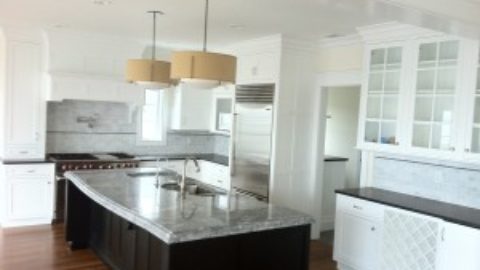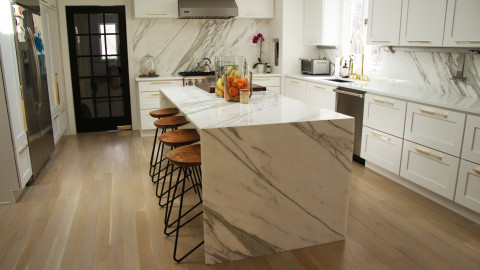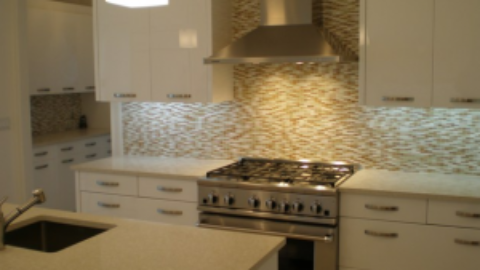When it comes time to make that final selection of natural stone for your design project, it may come as a surprise to find there’s more to consider besides the color and pattern of the slab. Not just the veining or the durability of the material for the application, but also the finish of the stone itself is an important consideration that cannot be overlooked.
Many consumers ask what the benefits or drawbacks are to one finish over another, and the aesthetics of each are of equal concern although sometimes overlooked or misunderstood. In this post, I’ll share the multitude of new and exciting possibilities of finishes on the natural stone market thanks to advancements in modern technology.
Centuries ago, highly polished stone was sought after for its opulence and grandeur. To bring a luster out of a stone took a tremendous amount of labor and time. Craftsman used sand granules of various sizes to exhaustively rub the stone until the surface came to life.
When stone slabs began to be mass produced the only goal was to produce them with as high a shine as possible, and all the equipment was calibrated to do just that. But within the last ten years, stone producers have begun to take notice of the changing trends in surface finishes led by designers and consumers.
Let’s review some of the different textures and finishes that are popular today.
Honed Finish
photo: Honed Solid 2″ Thickness Calacatta Marble for Butlers Pantry with Full Backsplash (ACD Project)
Picture a smooth and uniform surface with no shine. This honed matte surface has no reflection and is similar to a chalkboard. During the production of the slab, there are over ten steps of cutting, grinding and calibrating that need to be done in a specific order to reach the standard polished finish slab. Stopping before the final steps creates a honed finish stone.
The grain is still tight and closed, and when you run your hand across it there is no variation in its flatness. If the stone is dark, honing will lighten it up a few shades versus when polished. This allows greater versatility in searching for just the right tone in your design.
Playing off the neutral honed slab with other finishes in a project also adds visual interest. For example, your cabinets may be a high gloss or lacquered and a honed counter surface would create a nice contrast. Many designers prefer a honed finish for marble to help conceal any scratches or dull spots that may occur over time. You will notice that most travertine and limestone stones come only in a honed finish. This is due to the geochemical composition of the stone, which is a sedimentary material that cannot produce shine.
Antiqued or Leathered Finish
photo: River White Antique Finish Granite for Outdoor Bar Area (ACD Project)
What sounds like two very different names for finishes are in actuality quite similar and used interchangeably by fabricators in the stone industry. Antiqued and leathered natural stone slabs have a raised, stippled texture that resembles an orange peel. With diamond wire brushes, the slab surface is abraded just enough to expose some of the minerals in the stone, and digging into the softer ones. The final feel is warm and subtle to the touch.
Much like leather, the face of the stone when viewed from an angle shows slight undulations of minute peaks and valleys, again lightening the shade of the material as opposed to when it’s polished. This finish adds a very interesting focal point to the design and is inviting to the touch when compared to the polished, offering an old-world feel. It can also work well in a modern décor where textures are played against each other in a overall monochromatic palette.
Flamed Finish
Photo: Laurentian Green Flamed at the Hotel Vermont
As the name implies, a flamed slab has been subjected to the effects of intense heat, which is achieved by applying a high-temperature flame and adding cool water to the surface simultaneously. The flame fractures the crystals on the face while the water prevents splitting, leaving a rough-textured finish that has similar characteristics to the natural face of the stone as it comes from the earth.
This rough feel makes for an interesting contrast to other surfaces in a design and has an organic quality that cannot be replicated in other finishes. Thanks to the abraded quality of the stone, it’s an ideal choice for flooring applications where greater slip resistance is required, and especially in exterior settings where there may be heavy foot traffic.
The various ways that stone surfaces can be treated continue to grow, but these three comprise the most prevalent and popular in contemporary design. New advancements in technology are creating exciting alternative finishes, such as acid washed and chiseled. It is with these interesting options that architects, designers, and consumers are now able to broaden and expand their choices.
Let ACD Custom Granite’s craftsmen help guide you in your custom stone and finish selection and finish for your next interior or exterior design project. Contact us to make an appointment to visit our showroom and experience the feel of these finishes in person.









